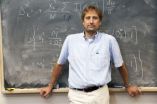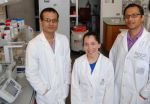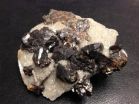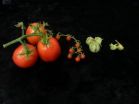(Press-News.org) Physicists have identified the "quantum glue" that underlies a promising type of superconductivity -- a crucial step towards the creation of energy superhighways that conduct electricity without current loss.
The research, published online in the Proceedings of the National Academy of Sciences, is a collaboration between theoretical physicists led by Dirk Morr, professor of physics at the University of Illinois at Chicago, and experimentalists led by Seamus J.C. Davis of Cornell University and Brookhaven National Laboratory.
The earliest superconducting materials required operating temperatures near absolute zero, or −459.67 degrees Fahrenheit. Newer unconventional or "high-temperature" superconductors function at slightly elevated temperatures and seemed to work differently from the first materials. Scientists hoped this difference hinted at the possibility of superconductors that could work at room temperature and be used to create energy superhighways.
Superconductivity arises when two electrons in a material become bound together, forming what is called a Cooper pair. Groundbreaking experiments performed by Freek Massee and Milan Allan in Davis's group were analyzed using a new theoretical framework developed at UIC by Morr and graduate student John Van Dyke, who is first author on the report. Their results pointed to magnetism as the force underlying the superconductivity in an unconventional superconductor consisting of cerium, cobalt and indium, with the molecular formula CeCoIn5.
"For a long time, we were unable to develop a detailed theoretical understanding of this unconventional superconductor," said Morr, who is principal investigator on the study. Two crucial insights into the complex electronic structure of CeCoIn5 were missing, he said: the relation between the momentum and energy of electrons moving through the material, and the 'quantum glue' that binds the electrons into a Cooper pair.
Those questions were answered after the Davis group developed high-precision measurements of CeCoIn5 using a scanning tunneling spectroscopy technique called quasi-particle interference spectroscopy. Analysis of the spectra using a novel theoretical framework developed by Morr and Van Dyke allowed the researchers to extract the missing pieces of the puzzle.
The new insight allowed them to explore the 30-year-old hypothesis that the quantum glue of superconductivity is the magnetic force.
Magnetism is highly directional, Morr said.
"Knowing the directional dependence of the quantum glue, we were able, for the first time, to quantitatively predict the material's superconducting properties using a series of mathematical equations," he said.
"Our calculations showed that the gap possesses what's called a d-wave symmetry, implying that for certain directions the electrons were bound together very strongly, while they were not bound at all for other directions," Morr said. Directional dependence is one of the hallmarks of unconventional superconductors.
"We concluded that magnetism is the quantum glue underlying the emergence of unconventional superconductivity in CeCoIn5."
The finding has "lifted the fog of complexity" surrounding the material, Morr said, and was only made possible by "the close collaboration of theory and experiment, which is so crucial in advancing our understanding of complex systems."
"We now have an excellent starting point to explore how superconductivity works in other complex material," Morr said. "With a working theory, we can now investigate how we have to tweak the system to raise the critical temperature -- ideally, all the way up to room temperature."
INFORMATION:
In addition to those mentioned above, Cedomir Petrovic of Brookhaven National Laboratory is a co-author on the study.
The research was supported by the U.S. Department of Energy under Contract DEAC02‐98CH10886 at Brookhaven and Award DE‐FG02‐05ER46225 at UIC.
Physicists unlock nature of high-temperature superconductivity
2014-07-28
ELSE PRESS RELEASES FROM THIS DATE:
Google searches hold key to future market crashes
2014-07-28
A team of researchers from Warwick Business School and Boston University have developed a method to automatically identify topics that people search for on Google before subsequent stock market falls.
Applied to data between 2004 and 2012, the method shows that increases in searches for business and politics preceded falls in the stock market. The study, 'Quantifying the semantics of search behavior before stock market moves,' was published in the Proceedings of the National Academy of Sciences.
The researchers suggest that this method could be applied to help identify ...
Memory relies on astrocytes, the brain's lesser known cells
2014-07-28
VIDEO:
Salk scientists have discovered the link between astrocytes and memory.
Click here for more information.
LA JOLLA—When you're expecting something—like the meal you've ordered at a restaurant—or when something captures your interest, unique electrical rhythms sweep through your brain.
These waves are called gamma oscillations and they reflect a symphony of cells—both excitatory and inhibitory—playing together in an orchestrated way. Though their role has been debated, ...
Scientists discover genetic switch that can prevent peripheral vascular disease in mice
2014-07-28
Millions of people in the United States have a circulatory problem of the legs called peripheral vascular disease. It can be painful and may even require surgery in serious cases. This disease can lead to severe skeletal muscle wasting and, in turn, limb amputation.
At The University of Texas Health Science Center at Houston (UTHealth) Medical School, scientists tested a non-surgical preventative treatment in a mouse model of the disease and it was associated with increased blood circulation. Their proof-of-concept study appears in the journal Cell Reports.
Unlike ...
Mineral magic? Common mineral capable of making and breaking bonds
2014-07-28
TEMPE, Ariz. - Reactions among minerals and organic compounds in hydrothermal environments are critical components of the Earth's deep carbon cycle, they provide energy for the deep biosphere, and may have implications for the origins of life. However, very little is known about how minerals influence organic reactions. A team of researchers from Arizona State University have demonstrated how a common mineral acts as a catalysts for specific hydrothermal organic reactions – negating the need for toxic solvents or expensive reagents.
At the heart of organic chemistry, ...
Forced mutations doom HIV
2014-07-28
CAMBRIDGE, MA -- Fifteen years ago, MIT professor John Essigmann and colleagues from the University of Washington had a novel idea for an HIV drug. They thought if they could induce the virus to mutate uncontrollably, they could force it to weaken and eventually die out — a strategy that our immune system uses against many viruses.
The researchers developed such a drug, which caused HIV to mutate at an enhanced rate, as expected. But it did not eliminate the virus from patients in a small clinical trial reported in 2011. In a new study, however, Essigmann and colleagues ...
Tennessee Surgical Quality Collaborative saves 533 lives and $75 million in 3 years
2014-07-28
NEW YORK (July 28, 2:45 pm [ET]): Ten hospitals in the Tennessee Surgical Quality Collaborative (TSQC) have reduced surgical complications by 19.7 percent since 2009, resulting in at least 533 lives saved and $75.2 million in reduced costs, according to new results presented today at the American College of Surgeons National Surgical Quality Improvement Program (ACS NSQIP®) National Conference in New York City.
The hospital collaborative was formed in 2008 as a partnership of the Tennessee Chapter of the American College of Surgeons and the Tennessee Hospital Association's ...
Stimulation of brain region restores consciousness to animals under general anesthesia
2014-07-28
Stimulating one of two dopamine-producing regions in the brain was able to arouse animals receiving general anesthesia with either isoflurane or propofol. In the August issue of Anesthesiology, investigators from Massachusetts General Hospital (MGH) report that rats anesthetized with continuous doses of either agent would move, raise their heads and even stand up in response to electrical stimulation delivered to the ventral tegmental area (VTA). Stimulation of the other major dopamine-releasing area, the substantia nigra, did not induce the animals to wake up.
"Dopamine ...
Study suggests disruptive effects of anesthesia on brain cell connections are temporary
2014-07-28
A study of juvenile rat brain cells suggests that the effects of a commonly used anesthetic drug on the connections between brain cells are temporary.
The study, published in this week's issue of the journal PLOS ONE, was conducted by biologists at the University of California, San Diego and Weill Cornell Medical College in New York in response to concerns, arising from multiple studies on humans over the past decade, that exposing children to general anesthetics may increase their susceptibility to long-term cognitive and behavioral deficits, such as learning disabilities.
An ...
UTSW cancer researchers identify irreversible inhibitor for KRAS gene mutation
2014-07-28
DALLAS – July 28, 2014 – UT Southwestern Medical Center cancer researchers have found a molecule that selectively and irreversibly interferes with the activity of a mutated cancer gene common in 30 percent of tumors.
The molecule, SML-8-73-1 (SML), interferes with the KRAS gene, or Kirsten rat sarcoma viral oncogene homolog. The gene produces proteins called K-Ras that influence when cells divide. Mutations in K-Ras can result in normal cells dividing uncontrollably and turning cancerous. These mutations are particularly found in cancers of the lung, pancreas, and colon. ...
Stress-tolerant tomato relative sequenced
2014-07-28
The genome of Solanum pennellii, a wild relative of the domestic tomato, has been published by an international group of researchers including the labs headed by Professors Neelima Sinha and Julin Maloof at the UC Davis Department of Plant Biology. The new genome information may help breeders produce tastier, more stress-tolerant tomatoes.
The work, published July 27 in the journal Nature Genetics, was lead by Björn Usadel and colleagues at Aachen University in Germany. The UC Davis labs carried out work on the transcriptome of S. pennellii — the RNA molecules that are ...





